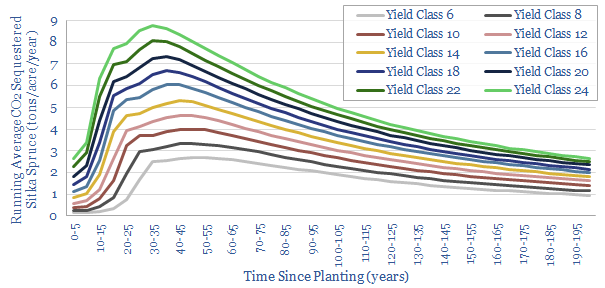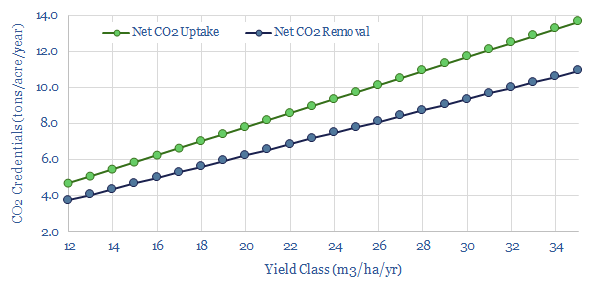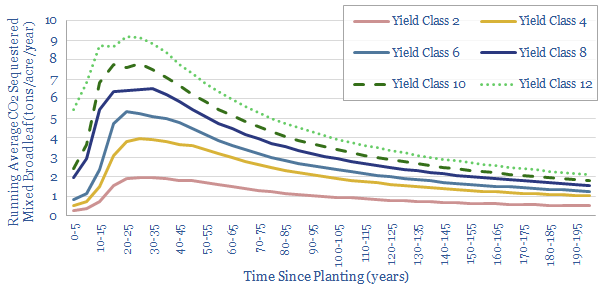Sitka spruce is a fast-growing conifer, which now dominates UK forestry, and sequesters CO2 up to 2x faster than mixed broadleaves. It can absorb 6-10 tons of net CO2 per acre per year, at Yield Classes 16-30+, on 40 year rotations. This short note lays out our top ten conclusions; including benefits, drawbacks and implications.
(1) Origins. Sitka spruce trees (Picea sitchensis) were first found in Baranof Island, in the Gulf of Alaska, in 1792, by Scottish Botanist Archibald Menzies. They was first brought to Europe in 1831, by another Scottish botanist, David Douglas (namesake of the Douglas fir). And they were named Sitka, after the headquarters of the Russian-Alaskan fur trade, which was the main reason Europeans were exploring the region at the time.
(2) Commercial Forestry Areas. In the UK, Sitka now comprises 30-60% of forest areas, following extensive planting since the 1970s (estimates vary). Likewise, in Ireland’s forests, Sitka Spruce represents 50-75% of all carbon stored and 90% of all wood harvested, across 300,000 hectares planted. Sitka is also grown to a lesser extent in Denmark, Iceland, France and Norway (although the latter now considers it invasive and is trying to phase it back).
(3) Growing Conditions. Sitka spruce naturally extend from Alaska down into Northern California, but seldom >200km inland or above 1,000m altitude. It is demanding of air and soil moisture, therefore grows best in temperate rainforests, coastal fog-belts or river-stream flood plains. It is also surprisingly light-demanding for a spruce, whereas one of the main advantages of Norwegian spruce in the forestry projects we are evaluating is that it is shade-tolerant, and can thus grow in below a pine canopy, adding carbon density. As usual, the right tree needs to be matched to the right climate to maximize CO2 removals (note below).
(4) Tree Sizes. Sitka is the tallest-growing spruce species in the world, usually reaching 45-60m height. Yet the world record is 96m. This is huge. The world’s largest Norwegian spruce (Picea abies) on record has reached 62m (in Slovenia), and the largest pine (Pinus sylvestris) is 47m (a 210-year old specimen in Southern Estonia). Sitka is the fifth largest tree in the world, behind usual suspects such as Giant Sequoia, where the tallest tree on record has reached 116m.
(5) Carbon Credentials. In Scotland, Sitka usually grows at 16-22 m3/ha/yr. In forestry, it is common to refer to a tree stand’s peak ‘Mean Annual Increment’ in m3/ha/year as its Yield Class. So 16-22 m3/ha/year would translate into Yield Class 16-22. In turn, the UK’s Woodland Carbon Code publishes excellent data for computing CO2 sequestration from yield classes (here). Yield classes 16-22 would translate into 6-8 tons of CO2 sequestration per acre per year.

(6) Even Higher Yield Classes have been reported by foresters growing Sitka, however, in the range of 30-45. For example, one source states that in Ireland Sitka yields can reach “34 tonnes per hectare per year of stem wood”, which would translate into a yield class in the 40-70 range. Some plots have reported the largest individual trees adding a full m3 of wood each year, which might translate into yield classes 50-100. But let’s not get carried away. It is not too difficult to translate yield class into CO2 uptake. For example, we would typically assume 450kg/m3 density for spruce, 50% of which is carbon. Each kg of elemental carbon is equivalent to 3.7 tons of CO2, and maybe 80% of absorbed CO2 can be prevented from returning to the atmosphere over the long run (note here, model here). This yields the chart below, suggesting 10 tons of CO2 removal per year at Yield Class 30.

(7) Carbon Comparisons. Sitka spruce has been called 2x as effective at carbon removals as traditional broadleaf woodland. Again, data from the UK Woodland Carbon Code would seem to bear this out, positing 4-6 tons of CO2 sequestration per acre per year for mixed broadleaves in their typical yield classes 4-8 (chart below). This matters because we tend to assume 5 tons of CO2 removal per acre per year for reforestation projects our roadmap to net zero.

(8). Commercial Forestry Practices. Underpinning our assumptions above for Sitka spruce are relatively dense plantings, at 1.5 – 2.0m spacings, which will translate into an extremely dense 1,000-1,800 trees per acre, grown over a 40-year rotation. Our numbers are averaged across thinned and unthinned stands, although the latter absorb 50% more CO2. This might all deflate the cost of a typical forestry project (including land purchase costs) from $40/ton CO2 pricing to around $25-30/ton CO2 pricing, while also lowering land requirements, which also matters for CO2 removals (notes and models below).
(9) Timber Uses. Sitka’s wood is light, strong and flexible, with a dry density around 450kg/m3. For comparison, hardwoods like oak are more typically 750kg/m3. Hence the Wright brothers’ Flyer was built using Sitka spruce, as it made the world’s first powered flight in 1903. In WWII the British even used it instead of aluminium to produce parts of the de Havilland DH.98 Mosquito military aircraft. Products derived from spruce range from packaging materials to construction timber. We think this presents an opportunity in the materials space, including in Cross Laminated Timber, where spruce is the most commonly used input material…
(10) Biodiversity Drawbacks. Biodiversity versus CO2 removal is always going to require trade-offs. A mono-culture Sitka spruce plantation will clearly be less bio-diverse than mixed broadleaf, but certainly more biodiverse than a Direct Air Capture plant. Overall, Sitka-heavy forests seem to be OK at promoting biodiversity. In America’s North-West, Sitka naturally grows alongside Western hemlock, Western re-cedar, Yellow cedar, mosses, horsetails, blueberries and ferns. In the spring, new growth can be eaten by mammals; while in the winter, needles can comprise up to 90% of the diet of bird species such as blue grouse.
Our conclusion for decision-makers is that Sitka spruce will help to accelerate prospects for nature-based carbon removals in the energy transition, creating direct opportunities in the forestry value chain, through to indirect opportunities in equities (notes below).
On a personal note, for the reforestation projects that we are undertaking in Estonia, we are mostly considering bio-diverse mixes with a backbone of pine and spruce. Attempts to grow Sitka in Estonia are more chequered. A 120-year old stand has reached 36m average height on the Island of Hiiumaa. This implies the ability to achieve 3,000m3/ha timber density, which is around 2.5x Norwegian spruce. However, other attempts to grow Sitka in Estonia have had mixed results, especially away from the Coast. So I would like to incorporate some Sitka in my plans here, but I am just not sure I can rely on them in this climate.